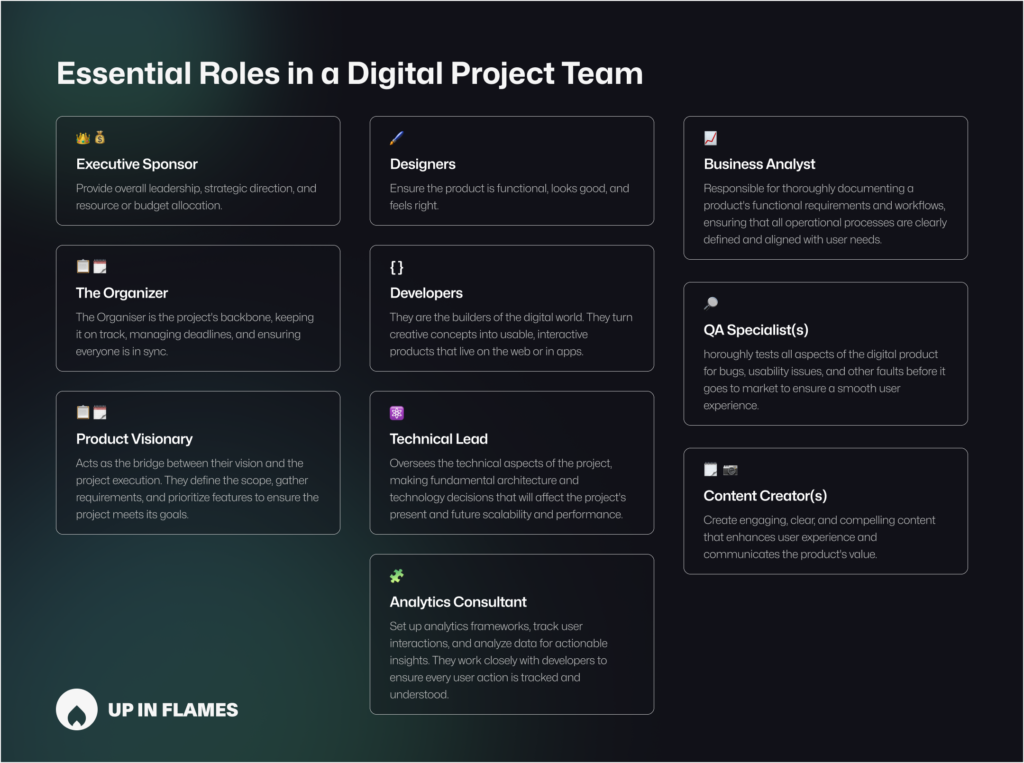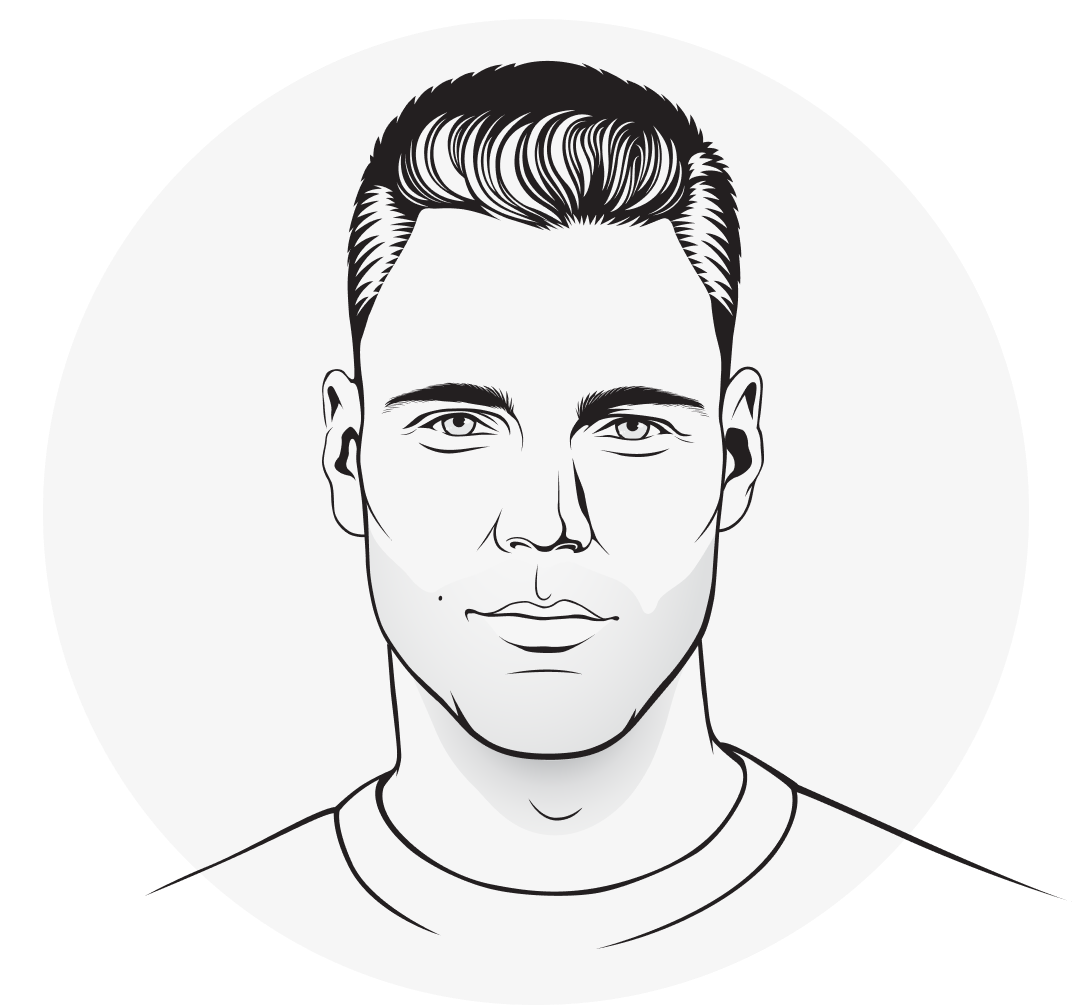Managing a digital project is a collaborative journey, with each role playing a crucial part in the project’s success. Here’s a breakdown of the essential roles I’ve encountered during my experience, each contributing to keeping things moving smoothly from start to finish. Your role is not just important; it’s integral to the project’s success.
Executive Sponsor
Titles: Project Sponsor, Senior Stakeholder, C-of-something.
Responsibilities: Provide overall leadership, strategic direction, and resource or budget allocation. They resolve high-level issues and ensure the project receives the necessary support from the business. However, conflicts can arise when the Executive Sponsor’s vision clashes with the Product Visionary’s or when resource allocation becomes a point of contention. The Executive Sponsor needs to maintain open communication with the team and be receptive to feedback and concerns.
Why They’re Needed: Their involvement is critical for gaining buy-in across higher levels of the organization and for pushing through obstacles that require executive authority.
The Organizer
Titles: Project Manager, Scrum Master, or Delivery Manager.
Responsibilities: The Organiser is the project’s backbone, keeping it on track, managing deadlines, and ensuring everyone is in sync.
Why They’re Needed: They’re the glue that holds the project together, sorting out issues and keeping everyone on the same page. They are the central brain of the operation and should know what’s going on at any point in the project, troubleshoot any issues, and lead the charge on anything and everything.
Product Visionary
Titles: Product Owner, Product Manager, Client Representative, Strategist.
Responsibilities: Acts as the bridge between their vision and the project execution. They define the scope, gather requirements, and prioritize features to ensure the project meets its goals.
Why They’re Needed: They align the project with strategic business goals and user needs, ensuring that it delivers real value and effectively meets its objectives.
Designers
Titles: UX Designer, UI Designer, and Animator.
Responsibilities: Depending on the product you’re building, you should likely have different types of designers. As a baseline, UX and UI are two different design roles. UX designers focus on the user journey and usability, while UI designers handle the product’s visual and interactive aspects. UX designers are more concerned with the overall user experience (and their output is often a wireframe). In contrast, UI designers focus on the product’s look and feel (and their output should be a Figma file with a styled app or website design).
Why They’re Needed: They ensure the product is functional, looks good, and feels right.
🧠 Other user-experience-oriented roles, such as Art Directors and Digital Strategists, often support designers to ensure the creative vision shines through in day-to-day design tasks.
💡 Level up your team with an animator to design delightful moments in your digital production; where can you add animation, and what should it look like?
Developers
Titles: Front-End Developer, Back-End Developer, Full Stack Developer.
Responsibilities: Developers translate the design into functional digital experiences. Front-end developers focus on what users interact with directly; back-end developers manage the server side and CMS, and full-stack developers can do both. Note that developers write in specific programming languages, which are not typically interchangeable.
Why They’re Needed: They are the builders of the digital world. Without their skills, designs remain mockups. They turn creative concepts into usable, interactive products that live on the web or in apps.
Technical Lead/Architect
Titles: Systems Architect, Lead Developer, Technical Architect, Technical Director.
Responsibilities: This person oversees the technical aspects of the project, making fundamental architecture and technology decisions that will affect the project’s present and future scalability and performance. They can also help advise when specific technical tests, such as performance, penetration, and other security tests, are needed.
Why They’re Needed: They ensure the project’s technical foundations are solid, scalable, and secure. Their expertise in systems architecture prevents pitfalls in software development by choosing the right technology stack and architecture.
Analytics Consultant
Titles: Data Analyst, Web Analyst.
Responsibilities: Set up analytics frameworks, track user interactions, and analyze data for actionable insights. They work closely with developers to ensure every user action is tracked and understood.
Why They’re Needed: In a data-driven world, analytics consultants ensure that data, not just assumptions, back decisions. They provide the insights needed to refine user experiences and increase project ROI. You want your Product Visionary to work closely with the Analytics Consultant to have insights drive the future vision.
Business Analyst
Titles: Business Analyst, UX Analyst, Process Designer.
Responsibilities: Use a Business Analyst’s analytical insight with a UX Designer’s user-focused design expertise. The analyst is responsible for thoroughly documenting a product’s functional requirements and workflows, ensuring that all operational processes are clearly defined and aligned with user needs. The analyst also creates detailed specifications and flowcharts that map how a product functions and interacts with users. This role can reside with the Product Owner/Visionary, depending on the role of documentation, or it should be a separate role depending on the project’s size, complexity, and the resources available.
- Smaller Projects: In smaller projects or teams with limited resources, a Product Owner might efficiently manage documentation, provided they have the skills and the documentation demands are manageable for their capacity to manage the product effectively.
- Larger Projects: For larger or more complex projects, especially those involving multiple teams or products, it’s beneficial to have a dedicated person handling specifications. This approach supports the Product Owner by handling documentation systematically and professionally.
Why They’re Needed: This role is vital for bridging a product’s technical functionalities and usability. By documenting and detailing how each aspect of the product works, they support the development team with clear guidelines and ensure that the end product is user-friendly and meets the intended business goals. Their work helps prevent miscommunications and ensures that the product functionality is fully understood by all stakeholders, including developers, marketers, and, crucially, the users themselves.
Quality Assurance (QA) Specialist
Titles: QA Tester, Software Tester.
Responsibilities: Thoroughly tests all aspects of the digital product for bugs, usability issues, and other faults before it goes to market to ensure a smooth user experience. They test the product and perform regression tests before a go-live moment to ensure everything works.
Why They’re Needed: QA specialists are crucial to maintaining the product’s integrity. They ensure the final product is functional, user-friendly, and defects-free, safeguarding the user experience and the project’s reputation.
Content Creator(s)
Titles: Copywriter, Content Strategist, Technical Writer, Videographer.
Responsibilities: Create engaging, clear, and compelling content that enhances user experience and communicates the product’s value. Ensure that all content aligns with the overall design and usability of the product.
Why They’re Needed: Effective content is vital to engaging users and conveying the product’s message. Content creators ensure that every piece of text, video, or graphic is purposeful and enhances the user journey.

Conclusion
Each role in a digital project team brings something unique to the table, and their collective efforts drive the project’s success. Before you launch your next project, ensure everyone is lined up to play their part and that there are clear channels of communication and collaboration. And remember, it’s all about the people.

